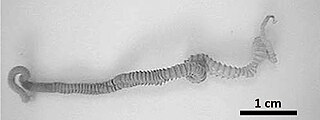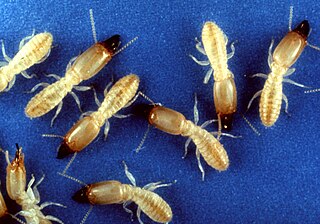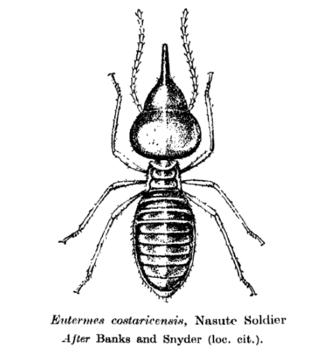
Termites are a group of detritophagous eusocial insects which consume a wide variety of decaying plant material, generally in the form of wood, leaf litter, and soil humus. They are distinguished by their moniliform antennae and the soft-bodied and often unpigmented worker caste for which they have been commonly termed "white ants"; however, they are not ants, to which they are distantly related. About 2,972 extant species are currently described, 2,105 of which are members of the family Termitidae.

Nasutitermes corniger is a species of arboreal termite that is endemic to the neotropics. It is very closely related to Nasutitermes ephratae. The species has been studied relatively intensively, particularly on Barro Colorado Island, Panama. These studies and others have shown that the termite interacts with many different organisms including a bat that roosts in its nest and various species of ants that cohabit with the termite.

Gigantorhynchus is a genus of Acanthocephala that parasitize marsupials, anteaters, and possibly baboons by attaching themselves to the intestines using their hook-covered proboscis. Their life cycle includes an egg stage found in host feces, a cystacanth (larval) stage in an intermediate host such as termites, and an adult stage where cystacanths mature in the intestines of the host. This genus is characterized by a cylindrical proboscis with a crown of robust hooks at the apex followed by numerous small hooks on the rest of the proboscis, a long body with pseudosegmentation, filiform lemnisci, and ellipsoid testes. The largest known specimen is the female G. ortizi with a length of around 240 millimetres (9.4 in) and a width of 2 millimetres (0.08 in). Genetic analysis on one species of Gigantorhynchus places it with the related genus Mediorhynchus in the family Gigantorhynchidae. Six species in this genus are distributed across Central and South America and possibly Zimbabwe. Infestation by a Gigantorhynchus species may cause partial obstructions of the intestines, severe lesions of the intestinal wall, and may lead to death.

Kalotermitidae is a family of termites, commonly known as drywood termites. Kalotermitidae includes 21 genera and 419 species. The family has a cosmopolitan circumtropical distribution, and is found in functionally arid environments.

Globitermes sulphureus is a species of termite that is very common in central and southern Vietnam and also present in other areas of South East Asia, including Cambodia, Thailand, and Peninsular Malaysia. They live in nests made of earth that can be up to 1.5 m tall and can contain tens of thousands of individuals. Between five and 10 per cent of the population are soldier termites which can be recognised by their yellow abdomen and two large, curved mandibles. The termites use autothysis as a defense mechanism.

Reticulitermes is a termite genus in the family Rhinotermitidae. They are found in most temperate regions on Earth including much of Asia and the Middle East, Western Europe, and all of North America.

Amitermes is a genus of termites in the family Termitidae. Species are found in a range of habitats including deserts and rainforests. Characteristics of Amitermes soldiers include a bulbous head, sickle-shaped mandibles with a single tooth on their inner margins and cephalic glands on the front of their heads.

The Nasutitermitinae is a cosmopolitan subfamily of higher termites that includes more than 80 genera. They are most recognisable by the more highly derived soldier caste which exhibits vestigial mandibles and a protruding fontanellar process on the head from which they can "shoot" chemical weaponry. True workers of certain genera within this subfamily also exhibit a visible epicranial y suture, most notably found within the members of Nasutitermes. Notable genera include the notorious wood-eating Nasutitermes, and the conspicuous Hospitalitermes and Constrictotermes, both genera characterized by their behavior of forming large open-air foraging trails.
Odontotermes globicola is a species of small termite of the genus Odontotermes. It is native to India, Malaysia and Sri Lanka. It is found under flower pots and decaying logs. They construct small chambered nest with spherical combed termitaria.
Dicuspiditermes nemorosus, is a species of small termite of the genus Dicuspiditermes. It is found in Sri Lanka, India, Malaysia and Borneo. The species is known to build three different types of mounding nests, where two termitaria have single protruding nest structure and third nest type is typified by several protruding nest all connected at the base.

Macrotermes carbonarius, also known as Kongkiak in Malay, is a large black species of fungus-growing termite in the genus Macrotermes. It is one of the most conspicuous species of Macrotermes found in the Indomalayan tropics, forming large foraging trails in the open that can extend several metres in distance. M. carbonarius is a highly aggressive species with the soldiers possessing large curving mandibles that easily break skin. It is found in Cambodia, Malaysia, Myanmar, Singapore, Thailand and Vietnam.
Amitermes floridensis, commonly known as the Florida darkwinged subterranean termite, is a species of eusocial insect in the family Termitidae. It feeds on rotting wood, reached by a network of tunnels. It is endemic to west central Florida and was first described in 1989.
Inquilinitermes is a genus of Neotropical termites described by Anthony G. Mathews that includes species found exclusively inside nests of another termite species in the genus Constrictotermes. For not being able to build their own nest, every species of Inquilinitermes has been commonly referred as an obligatory inquiline and its symbiosis with a host termite has been treated as inquilinism.

Syntermes is a genus of large Neotropical higher termites within the subfamily Syntermitinae. The genus is found only in South America where members are distributed widely throughout the continent, being found from the tropical rainforests of Colombia to the savannas of Brazil and Northern Argentina.
Glyptotermes is a genus of termite in the family Kalotermitidae. With 127 species worldwide as of 2013, is the family's most speciose genus, and the second most speciose in the New World after Cryptotermes.

Constrictotermes is a genus of Neotropical higher termites within the subfamily Nasutitermitinae. They form large open-air foraging columns from which they travel to and from their sources of food, similar to the Indomalayan species of processionary termites. Species of this genus commonly build epigeal or arboreal nests and feed on a variety of lichens, rotted woods and mosses.

Constrictotermes cyphergaster is a Neotropical species of open-air foraging nasute termite within the genus Constrictotermes. This species is distributed widely throughout South America and lives within xeric habitats such as the savannas found in Paraguay, Bolivia, Central Brazil, and Northern Argentina. C. cyphergaster primarily builds arboreal and transient epigeic nests and mainly consumes dead woods at varying stages of decomposition.
The Syntermitinae, also known as the mandibulate nasutes, is a Neotropical subfamily of higher termites represented by 21 genera and 103 species. The soldier caste of members of this subfamily have a conspicuous horn-like projection on the head which is adapted for chemical defense, similar to the fontanellar gun of true nasute termites. However unlike true nasutes, the mandibles of the soldiers are functional and highly developed, and they are unable to expel their chemical weaponry at a distance – instead relying on direct physical contact. Some genera, such as Syntermes or Labiotermes, have a highly reduced nasus and in some species it may appear absent altogether. Although the Syntermitinae were once grouped and considered basal within the Nasutitermitinae, they are not closely related with modern cladistic analyses showing Syntermitinae to be a separate and distinct lineage that is more closely related to either the Amitermes-group or MicrocerotermesTermitinae. It is believed the nasus evolved independently in Syntermitinae in an example of convergent evolution. Genera range from southern Mexico (Cahuallitermes) to Northern Argentina with the highest diversity occurring in the Brazilian Cerrado.
Rhynchotermes is a genus of Neotropical higher termites within the subfamily Syntermitinae, represented by 8 known species. Species of this genus are known for their soldiers which have highly developed sickle-shaped mandibles and a pronounced frontal tube superficially analogous to the fontanellar guns of true nasute termites. Most species forage above the surface in the open where they primarily feed on forest leaf litter. Nests are subterranean or are shallow and epigeic.

The Cubitermitinae are an Afrotropical subfamily of higher termites with 28 known genera and 147 species. The nests of most taxa are either subterranean or found within the mounds of other termite species. The most well known genus of this subfamily is Cubitermes, which commonly build epigeal nests with one or more caps used to shield the nest against rainfall, giving them a characteristic mushroom shape. Most members of this subfamily are soil-feeders.












